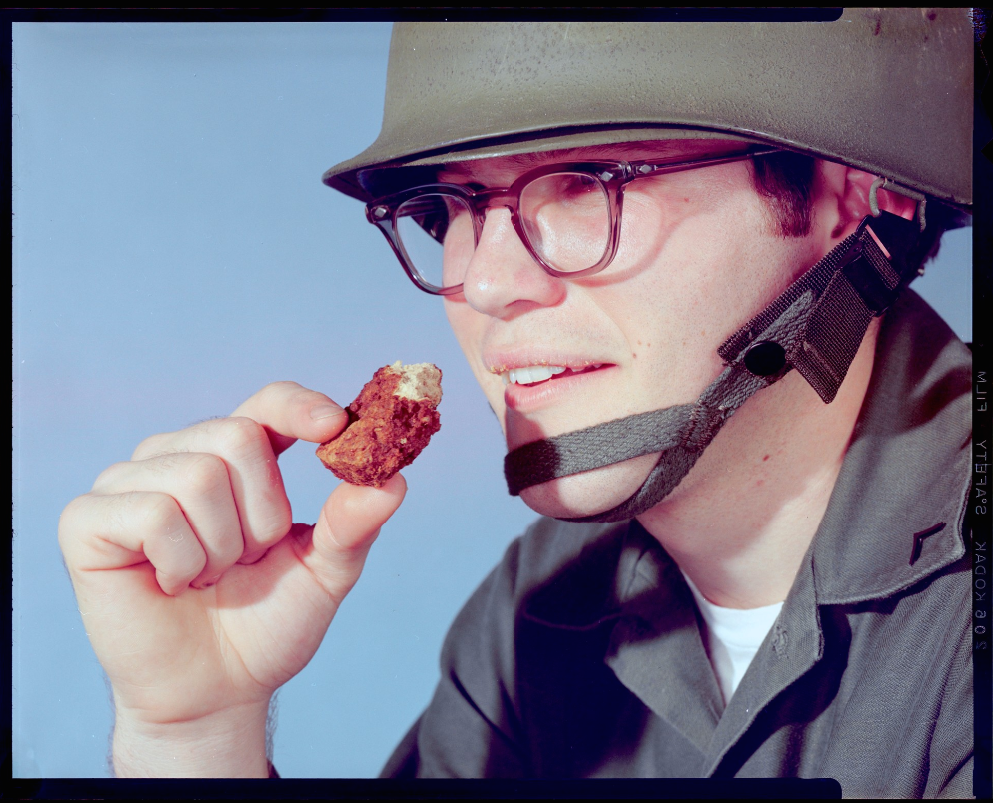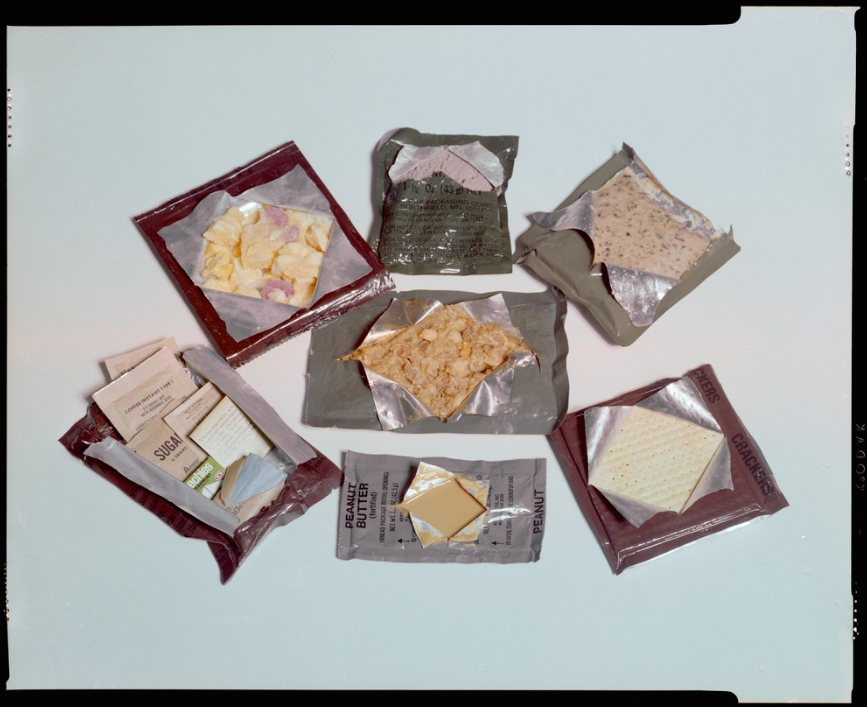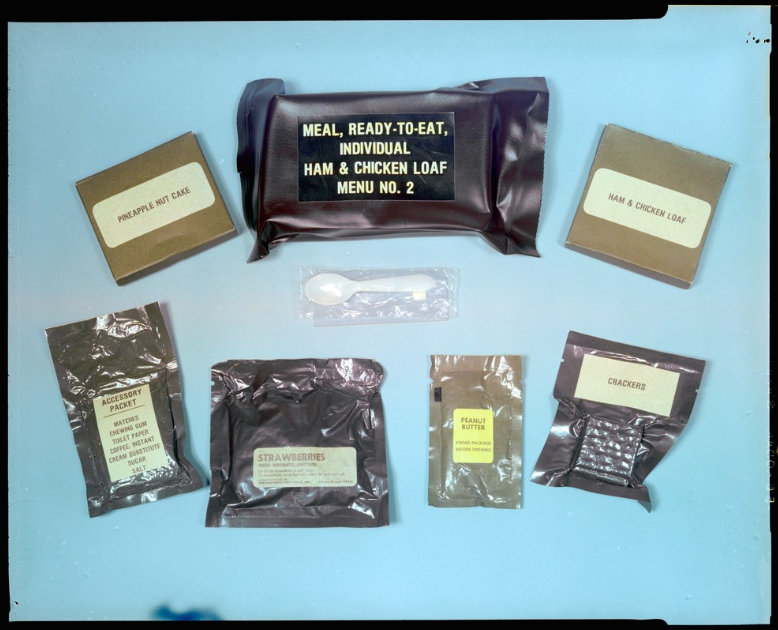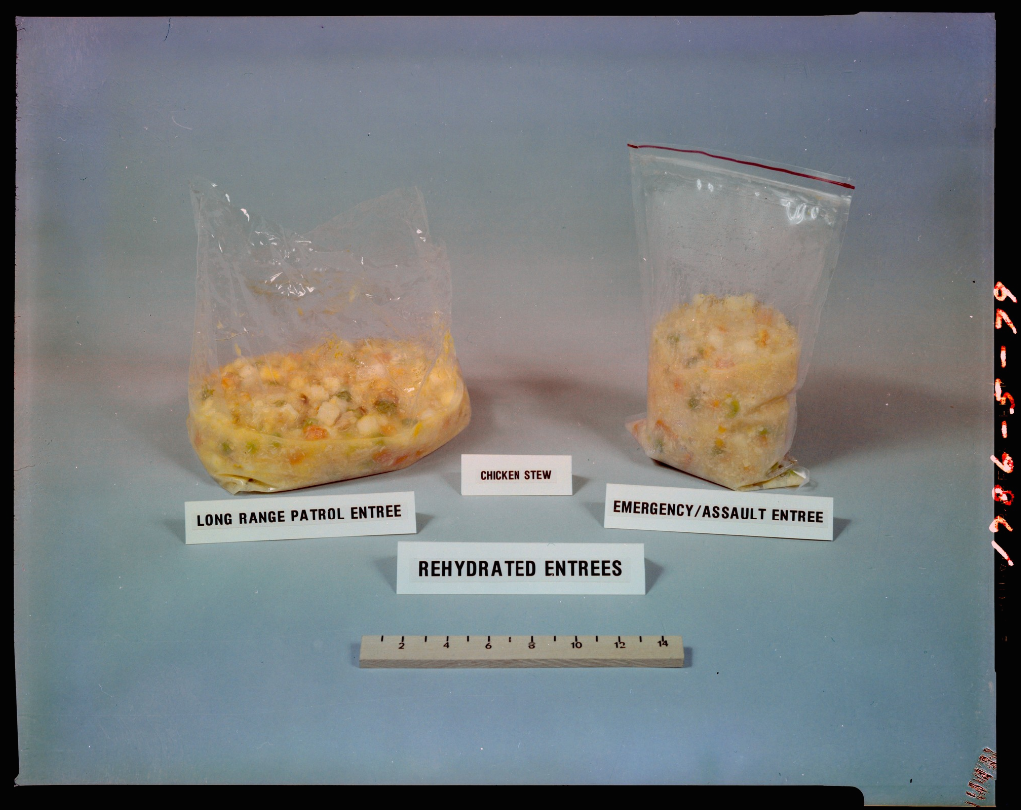The Combat Ration Collectors Who Eat Decades-Old Military Meals
Beef stew from 1983, anyone?

A G.I. eating a compressed dehydrated vegetable bar in 1971. (Photo: Natick Soldier Systems Center Photographic Collection/CC BY 3.0)
Even if they’ve been baked to perfection and stored in an airtight tin, cookies just don’t taste so scrumptious when they’re 71 years old. Youtube user Steve1989 can tell you this from personal experience.
In January, Steve—who keeps his last name secret—uploaded a video to YouTube in which he opened a tin of Canadian army rations that had been packaged in 1945. “Oh, man. Those smell awful,” he said, as he unwrapped the foil surrounding a dozen cookies.
He tasted one.
“Hmm. That’s pretty disgusting.”
He ate the whole cookie. Then he ate four more. Satisfied with the breadth of that taste taste, he moved on to sample the next packet: a cylinder of 71-year-old chocolate pellets.
Steve1989 is a ration reviewer. He’s part of a growing online community of people around the world who collect, swap, and taste-test military MREs—the self-contained, robustly packaged “Meals, Ready to Eat” that get doled out to soldiers in the field.

A typical long-range patrol ration pack. (Photo: Natick Soldier Systems Center Photographic Collection/CC BY 3.0)
Whether decades old or freshly packaged, MREs are not known for their gourmet flavors. Designed to provide sustenance to active troops in combat situations, they generally consist of an entree, side dish, dessert, and vacuum-packed snacks, which together form one high-calorie meal. Utensils, powdered drink mixes, and a flameless heating device for warming up the main dish round out the package, which is often colored khaki to blend in to the rest of a soldier’s kit.
This less-than-appetizing meal might be assumed to have little appeal outside the military. But civilians are interested in MREs for a few reasons. Some are ex-military, and develop a nostalgic curiosity. Others are concerned with emergency preparedness. Still others fall into a YouTube hole, end up watching a guy sample a vacuum-packed tuna-noodle entree from 1989, and get hooked on the MRE buy-swap-sell phenomenon.
Fifteen years ago, MRE enthusiasts had no way of establishing a community. Then a man named Kinton Connelly arrived on the scene. In 1999, Connelly, who lives in Charlotte, North Carolina, started noticing MREs—“these little, almost unmarked brown packages,” as he calls them—popping up as part of emergency preparedness plans for Y2K. “I’d seen them at various shows and army surplus stores,” he says. “I’d never tried one, but I was always fascinated by it, so when Y2K came around I started looking for some more information about them.”

MRE pouches, opened to display the enticing contents. (Photo: Natick Soldier Systems Center Photographic Collection/CC BY 3.0)
The Y2K disaster, of course, was a huge anti-climax. But the lead-up did take Connelly in a new direction—having found scant information on MREs, he “kept digging and digging,” eventually amassing a wealth of details on MRE history and menus. He launched MREinfo.com in 2003 with the aim of sharing his knowledge. Two years later, in response to multiple requests, Connelly added a forums section to the site so MRE collectors could talk to one another.
“To my shock and surprise, it really took off—and not just with people in the U.S., but people from all over the world,” he says. “Once the international visitors started coming in, there was a lot more trading that started happening.”
American collectors could finally get their hands on the fabled Italian army rations that came with mini liquor bottles. Packages started zooming around the world. Coveted French and British army rations began landing in U.S. mailboxes, ready to be sampled and reviewed.

Egyptian combat rations from 1992. (Photo: Natick Soldier Systems Center Photographic Collection/CC BY 3.0)
Today, most reviewers get their military MREs from other collectors, or buy them on eBay. Some of the companies that supply MREs to the military also sell civilian versions of their meals, but the authentic combat versions are the most sought-after among collectors.
Technically, U.S. military MREs aren’t supposed to be sold to civilians—the phrase “Commercial sale is prohibited” is printed on snack packets. “I wouldn’t say it’s strictly illegal to get them,” says Connelly, “but I’d also be remiss if I didn’t say that sometimes MREs didn’t fall off a truck.” Though he knows of “cases where the army’s criminal investigation unit has tracked down eBay auctions to see who’s selling them,” Connelly says it’s rare for MRE collectors to run into trouble over the legality of their hobby.
This is good news for the small but dedicated bunch of MRE reviewers who post their taste tests on YouTube. This is a relatively new part of the MRE community, having popped up in the last five years. In May 2011, a Brookline, Massachusetts-based man who goes by gschultz9 posted a review of an eight-year-old MRE that he tasted while camping on Cape Cod. Encouraged by the positive response among collectors, he started posting more videos, and hasn’t stopped since.

An MRE featuring the widely reviled ham-and-chicken loaf entree. (Photo: Natick Soldier Systems Center Photographic Collection/CC BY 3.0)
Unlike Steve1989, who specializes in eating decades-old army rations while reminding viewers he doesn’t have health insurance, gschultz9 doesn’t aim for daredevilry in his taste tests. “My style isn’t that exciting,” he says, referring to his reviews as “straightforward, informational kind of videos.” He has a theory that “a good chunk” of his audience tunes in because his soothing voice helps put them to sleep. Still, enough people must be watching all the way through—his home is currently filled with MREs from around the world, sent to him by people seeking reviews.
Though gschultz9 does occasionally taste-test MREs that are over a decade old, “it hasn’t really been my thing, per se,” he says. “It’s always kind of scary. I actually just did one yesterday that was only eight years old, but it had Pop Tarts in it, and they had this strange white thing on them, I couldn’t figure out if it was crystallized sugar or mold. I decided not to eat more than two bites of it.”

Rehydrated U.S. army ration entrees from 1979. (Photo: Natick Soldier Systems Center Photographic Collection/CC BY 3.0)
Usually, it’s pretty easy to tell if a ration pack has gone off. Sometimes all you need to do is look at the packaging. “When an MRE’s been punctured and bacteria’s gotten inside, that sucker swells up pretty bad,” says Connelly. Other times, the realization hits when a reviewer opens a can or package to find black applesauce, sour jam, or M&Ms that have turned to dust.
The condition of the food often depends on how the MRE was stored over the years, and whether it was knocked around or exposed to extreme temperatures. In a particularly entertaining MREinfo.com review of a 1982 pork patty meal, the taster declared that “the only edible thing I found in this MRE was the salt.”

(Photo: Natick Soldier Systems Center Photographic Collection/CC BY 3.0)
Though it’s disappointing to open an MRE and find it’s gone bad, that’s all part of the adventure—and an opportunity to consult the community. Collectors commiserate in YouTube comments and on the MREinfo.com forums, sharing stories of horrid, rancid smells and seeking advice on whether to eat meal components that seem iffy.
“Everybody’s pretty supportive of each other,” says gschultz9, citing YouTube users Kiwi Dude, gundog4314, and steve1989 as the recently emergent go-to gurus for MRE swaps and advice. “It’s still a very niche thing, obviously,” he says, but the small group is “a very calm, cool community.”
The appeal of military MREs is still lost on many, however. Connelly notes that he receives “emails saying ‘Why do you have a website about this? I was in the service, and I never want to see one of these things again.’” But to collectors, they are historic packages of combat cuisine just waiting to be unwrapped and tasted.
Steve1989 sums it up as he struggles to swallow a stale, rancid-smelling World War II cookie: “Why? Why not. This is what we do.”
Gastro Obscura covers the world’s most wondrous food and drink.
Sign up for our email, delivered twice a week.





























Follow us on Twitter to get the latest on the world's hidden wonders.
Like us on Facebook to get the latest on the world's hidden wonders.
Follow us on Twitter Like us on Facebook